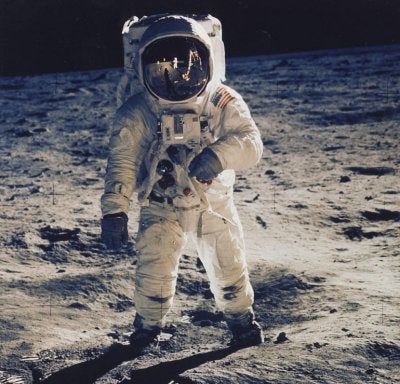Long before American astronaut Neil Armstrong set the first human foot on the Moon in July 1969, space-flight visionaries had worked out all the details. They had published imaginative flight plans, complete with picture-yourself-here paintings, in magazines with circulations that numbered in the millions. These articles then appeared, suitably embellished, in excitingly illustrated books that sold the vision in almost how-to detail.
Yet more than a generation after Armstrong left his epochal boot-print in moondust, the Apollo program still remains humankind’s high-water mark. Worse, there’s no sign that today’s astronauts will ever venture farther from home than low Earth orbit.
So what happened?
Briefly, the Cold War. Which is highly ironic, since without the Cold War’s superpower rivalry driving both the United States and the Soviet Union into technological competition, we’d probably still be awaiting the first steps to be taken in the grand plan for the conquest of space. But after 1945, when German engineer Wernher von Braun’s V2 rockets showed that missiles could rain explosives onto an enemy free of interception, the pace of rocket development was driven hard, and almost entirely, by military needs. In part these needs paralleled what the space-flight pioneers had been clamoring for, but they had at their core a totally different motivation.
For the military, space flight did not offer knowledge of the solar system nor the thrill of exploration. Rather, the military sought access to the highest of high grounds from which to see what the enemy was up to and then to stop him. From this need grew an armada of rockets for all kinds of purposes, including some powerful enough to take human beings into space and to another world.
The shock that the Russian satellite Sputnik gave to Americans in October 1957 can hardly be exaggerated. Overnight, it created an irresistable political momentum to demonstrate to the Soviets and the world that American technology was second to none. By hitchhiking on military rocket development, civilian space exploration gained access to space and entered a golden era.
But the deal was a Faustian one. The space-flight dreamers were pursuing what amounted to a religious quest — the migration of humanity into space. The politicians were engaged in a very down-to-Earth national competition. It’s highly symbolic that the man who had done the most to create military rocketry was the same one who designed and built the Saturn V spaceship to take Americans to the Moon: Wernher von Braun.
Once the Russians were beaten in the Space Race, however, the grand marriage of convenience between space-flight dreamers and politicians began to fall apart. Again, irony steps in. The year 1989 saw both the last first visit of an unmanned spaceprobe to a planet — Voyager at Neptune — and the start of the Soviet Union’s collapse as a rival for the United States.
Today, human space flight stands at a crossroads. Astronauts, cosmonauts, and now taikonauts ride their rockets into space or, more precisely, low Earth orbit. The action is thrilling and photogenic, and every year it inspires probably millions of kids to dream of joining them. The paradox of the International Space Station, humanity’s current space pinnacle, is that it simultaneously represents both a direct on-ramp to exploring the planets — and a cozy halfway house we’ll never go beyond. Which role it will play in this century remains undecided.
Yesteryear’s dreams of space didn’t pan out the way the dreamers envisioned. And for our part, we still have yet to find a new vision powerful enough to send human beings to other worlds.










